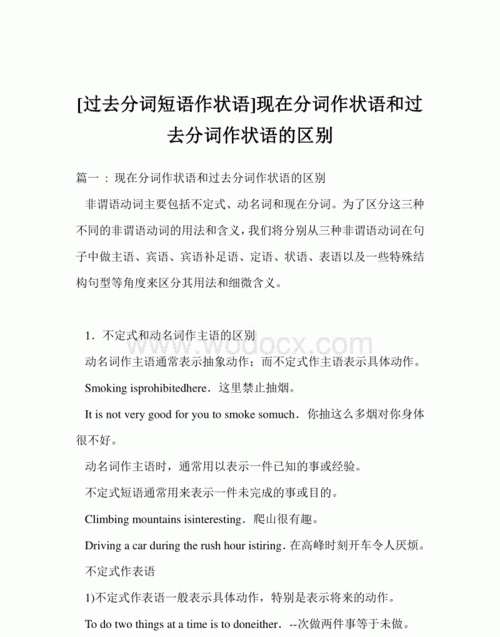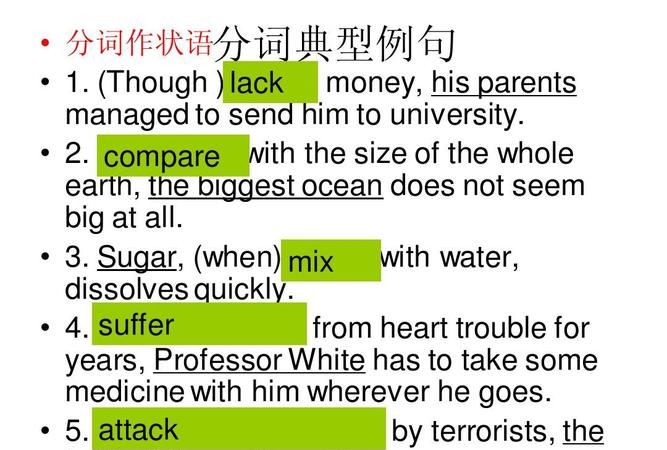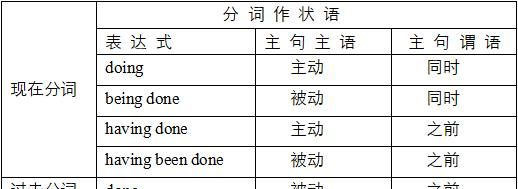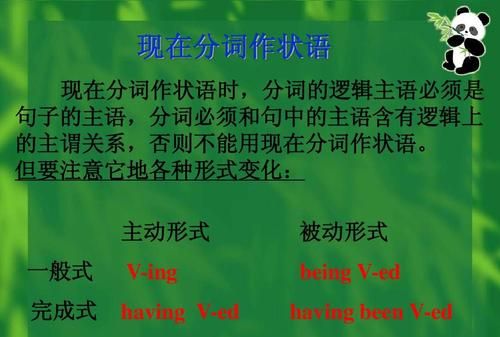本文目录
形容词分词作状语的用法总结
分词作状语的用法总结
非谓语动词短语的形式包括动名词、现在分词、过去分词、动词不定式,它们在句子中可以充当不同的句子成分,本文就来谈一下如何处理考研英语中分词作状语的情况。
一、表时间,可以和时间状语从句互换。如:
Studying in the university, he was very popular among his classmates.
When he studied in the university, he was very popular among his classmates.
Seeing those pictures, she remembered her childhood.
When she saw those pictures, she remembered her childhood.
二、表原因,可以和原因状语从句互换。如:
Not knowing her address, I wasn't able to contact her.
Because I did not know her address, I wasn't able to contact her.
三、表条件,可以和条件状语从句互换。如:
Walking to work, you will save quite a lot of money.
If you walk to work, you will save quite a lot of money.
四、表让步,可以和让步状语从句互换。如:
Defeated, he remained a popular boxer.
Although he was defeated, he remained a popular boxer.
五、表方式,如:
He earns a living driving a truck.
I'm returning you letter as requested.
六、表伴随,如:
Losing a job is hurting: you don't skip down to the job centre with a song in your heart, delighted at the prospect of doubling your income from the generous state.(考研阅读真题2014 Text 1)
在这个句子中,delighted分词短语作伴随状语,表示去求职中心的状态。
七、表结果,分词短语作结果状语在考研英语阅读中经常出现,并作为因果逻辑关系的考点出现在题干和选项中,请大家一定要注意非谓语动词短语的这种语法功能。如:
The best lawyers made skyscrapers-full of money, tempting ever more students to pile into law schools. (考研阅读真题2014 Text 2)
在这句话中,tempting分词短语作结果状语,表示最好的律师挣钱很多这种现象带来的结果是引起更多学生考法律学校。题干中的问题是A lot of students take up law as their profession due to,即学生学法律专业的原因是什么,这个问题从上句话中就可以找出答案,是因为经济回报的吸引,即选项the attraction of financial rewards。
By offering on-trend items at dirt-cheap prices, Cline argues, these brands have hijacked fashion cycles, shaking an industry long accustomed to a seasonal pace. (考研阅读真题2013 Text 1)
在这个句子中,shaking 分词短语作结果状语,表示品牌绑架时尚圈的后果。
Science and technology would cure all the ills of humanity, leading to lives of fulfillment and opportunity for all. (考研阅读真题2013 Text 3)
在这个句子中,leading分词短语作结果状语,表示科技将治愈人类所有疾病后带来的结果。
八、与逻辑主语构成独立主格,如
Human nature being what it is, most people stick with default settings. (考研阅读真题2013 Text 2)
在这种结构中,需要注意非谓语动词的主语是其前出现的名词或名词短语。Being what it is 的逻辑主语是human nature, 翻译为人类本性就是这样。

现在分词短语作状语英语造句
(时间)1.Hearing the cry for help, he rushed out.
2.Having finished doing his homework, he goes on to watch TV.
(条件)3.Seeing from the hill, you can get the whole town.
4.Boiled, the water can be drunk.
5.Given more time , I can finish all the work.
(原因)6.Thinking that the petrol in the car would catch fire, they ran to the damaged car and pulled Tom out of it.
(方式)7.The farmer came riding by and lent him a hand.
(伴随)8.He read a magazine, waiting for the bus.
应该每个类型都涉及了 自己选择吧

ing分词做状语的高考例句
现在分词是英语中一个非常重要的语法知识,那么你知道ing分词做状语句子有哪些吗?下面是我为你整理的ing分词做状语的句子,希望大家喜欢!
ing分词做状语的句子
现在分词作伴随状语
例句1:Smoking a cigarette , he entered the meeting hall.
他抽着烟,走进了会议厅。
例句2:I gazed into the dark sky thinking about where I would belong.
凝望着漆黑的夜空,我心里思索着路在何方。
注释:现在分词作伴随状语,表示非谓语动词所表达的动作或状态是伴随着句子谓语动词的动作或状态而发生的。
现在分词作条件状语
例句1:Throwing yourself into your study, you will find it pleasant and productive.
如果你投入到你的学习中去,你会发现学习即愉悦又有收获。
例句2:Speaking in English everyday, you will hander this language step by step.
每天都用英语说话,你会一步一步掌握这门语言。
注释:现在分词作条件状语时相当于一个If引导的条件状语从句。比如例句1也可以写成:If you throw yourself into your study, you will find it pleasant and productive.
现在分词作时间状语
例句1:Seeing the actors singing and dancing, the little baby did likewise.
当看到演员们载歌载舞的时候,小宝宝也学者手舞足蹈。
注释:相当于when he saw the actors singing and dancing, the little baby did likewise.
例句2:Having finished reading passage one, we then moved on to the second passage.
完成第一章之后,我们进而进入第二章。
注释:相当于After we finished passage one, we then moved on to the second passage.
现在分词作让步状语
例句1:Being a kid, he has much knowledge about love affairs.
虽然是个孩子,他知道很多关于爱情的事。
例句2:Having learned English for years, he still can't speak freely.
虽然学了很多年英语,但是他还是不能自由交谈。
注释:例句1和例句2都可以变换成though引导的让步状语从句。比如例句1也可以写成Though he is a kid, he has much knowledge about love affairs.
现在分词作原因状语
例句1:Being sleepy, the boy couldn't focus on his study.
因为很困,这个男孩不能把注意力集中在学习上。
例句2:Not having prepared well, the speaker paused at times.
由于之前没有准备好,这个发言人老是停顿。
注释:这两个句子中的非谓语动词作状语的部分都可以用because引导的原因状语从句来代替。比如例句2可以写成Because he had not prepared well, the speaker paused at times.
现在分词作结果状语
例句1:I slipped and fell down on the glassy ground, breaking my arms.
我在光滑的地面滑到了,结果摔断了胳膊。
例句2:He arrives school very late everyday, making his teacher very angry.
他每天都很晚到达学校,这让他的老师很生气。
注释:例句中的现在分词作结果状语可以用一个结果状语从句代替,比如例句1可以变换成I slipped and fell down on the glassy ground, and as a result I broke my arms.
ing分词作状语的注意事项
如果一个中心语前面有好几个状语(多层状语),那就应当注意它们的语序.多层状语的状语个数一般比多层定语的定语个数要少些,其语序也比多层定语的语序要灵活一些. 多层状语的一般语序: a.表时间的名词或方位短语,介词短语. b.副词. c.表处所的介词短语或名词,方位短语. d.表情态的形容词或谓词短语. e.表对象的介词短语. 其中副词的位置较为灵活,也可放置在第三项之后.
状语在句子中有两种位置:一种是在主语之后,谓语中心之前,如上文所举各例,这是状语的一般位置;另一种是放在主语的前面的,这是状语的特殊位置,这种状语可称“句首状语”.
现在分词的释义
现在分词(present participle)(又称-ing形式,现在进行式) ,是分词的一种,分词又分为现在分词和过去分词,它们都是非限定动词,现在分词在句子里面不能单独充当谓语,但能充当其它的一些成分(定语,表语,补语,状语),并且它们具有动词的性质,所以又是类动词的一种。一般式:doing; 一般被动式:being done; 完成式:having done; 完成被动式:having been done。 所有否定式都是在-ing前面加not ,包括独立主格形式。
现在分词在英语这一科目中,也是比较重要的一部分,具有双重性,一面具有动词的特征,可以有自己的宾语和状语;另一面具有形容词和副词的特征,可以充当表语,定语,状语,补足语,可以表示主动或正在进行的动作,是非谓语动词的一种。

现在分词作状语的例句英语
一、作时间状语 如果现在分词的动作和主谓语的动作同时发生,分词用一般式,有时其前可以加上连词while或when。例如: ①Hearing the news,they all jumped with joy.(=When they heard the news,they...) 听到这个消息时,他们都高兴得跳了起来。 ②Walking slowly across the grass,he pointed the gun at the lion and fired. 他慢慢地走过草地,把枪对准狮子就射击了。 ③One day,while walking along the sands towards his boat,Crusoe saw in the sand the mark of a man's foot. 有一天,克鲁索沿着沙滩走向他的船时,在沙子里看见一个人的脚印。 如果现在分词的动作结束之后,谓语动词的动作才发生,现在分词应用完成式。这时分词所表示的动作有一定的持续性。如果用一般式就会给人感觉到似乎是"某人在做某事时就开始做某事",容易产生误解。但是,如果现在分词是hear,see等表示感官的动词或是leave,arrive,turn,open等表示位置转换或情况改变的动词,现在分词所表示的动作发生后,主句的动作往往紧接着发生,那就不必用完成式,仍用一般式。例如: ①Having watered the flowers(=After/When he had watered the flowers),he began to cut the grass. 他把花浇好后,开始割草。 ②Having eaten his dinner,the boy rushed out. 那男孩吃完了饭就跑出去了。 ③Hearing the footstep below(=When he heard the footstep below),he rose and went to the top of the stairs. 听见下面脚步声,他站起身来走到楼梯口去。 ④Seeing a large cake flying through the air,the driver pulled up quickly. 司机看见一只大蛋糕在空中掠过,赶紧刹车。 二、作方式状语 现在分词作方式状语很容易与伴随状语、同位语、定语相混淆。试分析下列句子: ...But later,people developed a way of printing,using rocks. ……但是以后,人们利用石块发展了印刷术。 有人对该句using rocks提出了以下看法: 1)把它视作相当于一个非限制性定语从句。 2)把它视作a way of printing的同位语。 3)把它视作状语,表示伴随情况或方式。 笔者赞成第三种看法,表示方式状语(但不是伴随状语)。因为句中using rocks表明人们用什么方法发明了一种印刷方法,是涉及到用how或by what means的回答问题,所以,如果把句中using前的逗号去掉,改为by,则句意保持不变。又如: He earns a living by driving.他靠开卡车谋生。 They would be ableto reply to our signals by using similar methods. 他们将能用同样的方法回答我们的信号。 三、作目的状语例如: ①Pappy ran out to the gate and told him not to come fooling(=to fool)round there no more. 巴比跑到大门口去叫他不要再到这儿来游荡。(钱歌川,《英语疑难详解》P237) ②The six blind men stood there begging for a meal.(=in order to beg for a meal)六个瞎子站在那儿要饭。 四、作结果状语例如: ①I thought he was making fun of me,and ran faster than ever,reaching(=so that I reached)the school yard quite out of breath. 我想他在拿我开玩笑,就越发跑得快了,到达校园时已经上气不接下气。 ②Her husband died ten years ago,leaving her with three children to look after.她丈夫十年前去世了,撇下她和三个孩子。 五、作伴随状语 伴随状语的特点是:它所表达的动作或状态是伴随着句子谓语动词的动作而发生或存在的。例如: ①He sat in the armchair,reading a newspaper. 他坐在扶手椅里读报。 ②All night long he lay awake,thinking of the problem. 他整夜躺在床上睡不着,思考着那个问题。 六、作原因状语 现在分词短语作原因状语,尤其是be,feel,know,recognize,fear等状态动词的现在分词(短语),以及现在分词的否定式用作状语时,通常表示 原因。例如: ①Being sick,I stayed at home.我因病呆在家中。 ②Not knowing her address,I can't write to her.由于不知道她的地址,我没法给她写信。 ③Not having done(=As he has not done)his homework,he stayed at home. 由于他没完成作业,只好呆在家里。 七、作条件状语例如: Taking(=If you take)the path that leads out of the town,you will come to a dense wood. 如果你沿着通向郊外的小道前进,就会走到一片密林处。 八、起补充说明作用 现在分词短语起补充说明的作用与伴随状语有些相似,但严格地说,它不是伴随状语,因为它所表达的情景不与句子的动作相伴而产生,实际上,它起着补充说明的作用,相当于一个并列分句,但比分句简洁、明快。例如: ①My train leaves at six,arriving in Chicago at ten.=...and will arrive in Chicago at ten. ②The visiting Minister expressed his satisfaction with the talks,adding that he had enjoyed his stay here.=...and added that he had enjoyed his stay here.

以上就是关于分词作状语高级句子 ,形容词分词作状语的用法总结的全部内容,以及分词作状语高级句子 的相关内容,希望能够帮到您。
